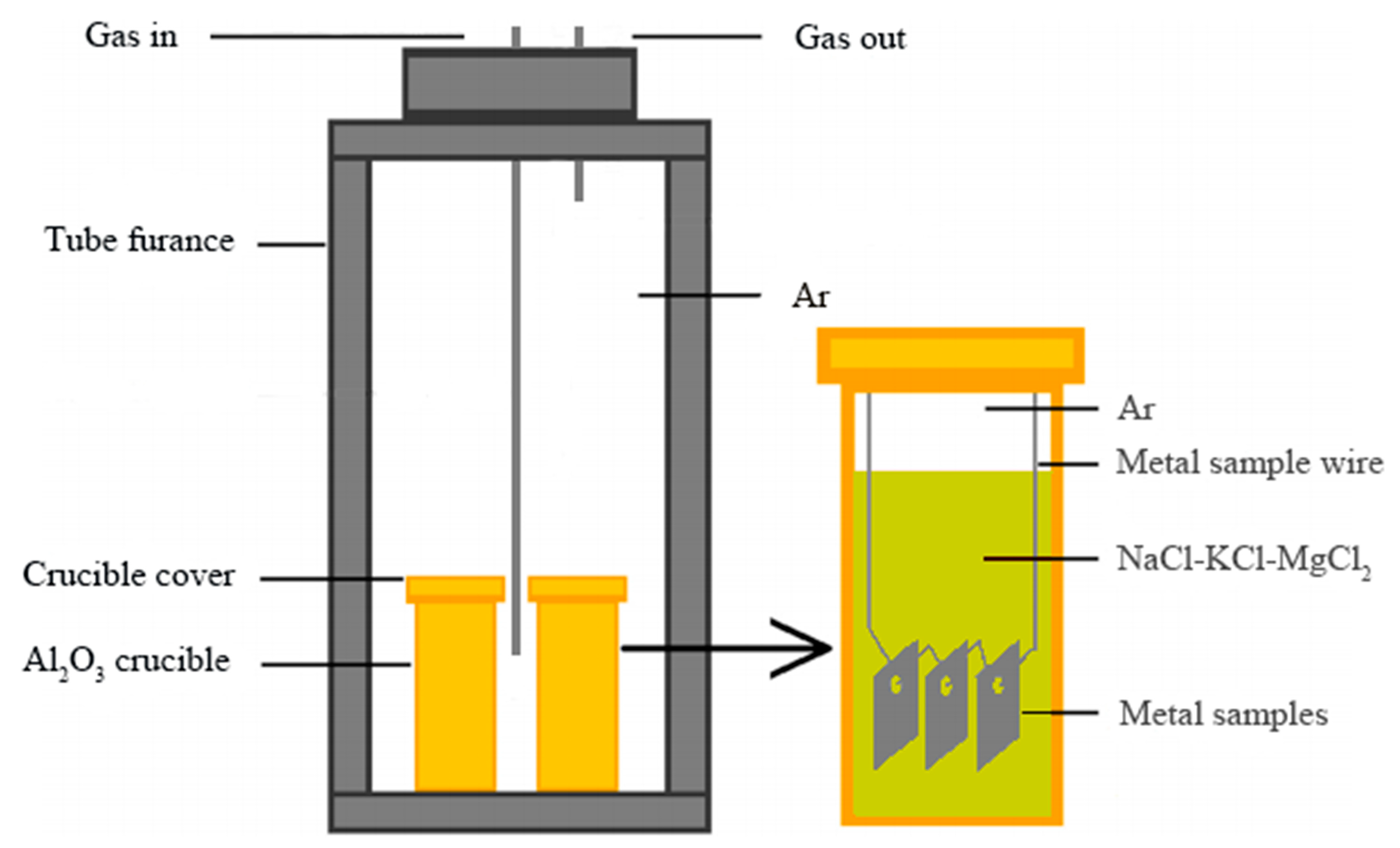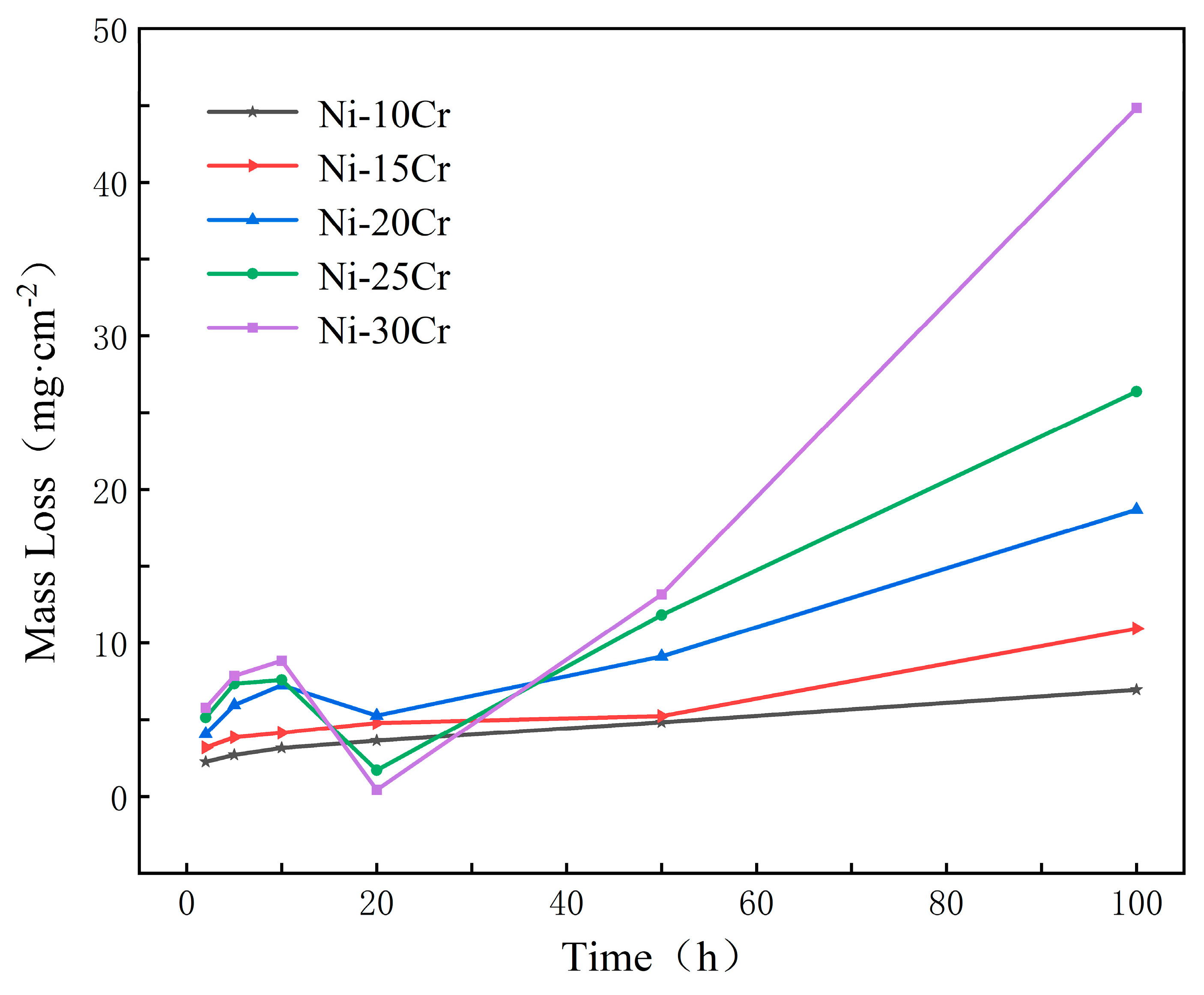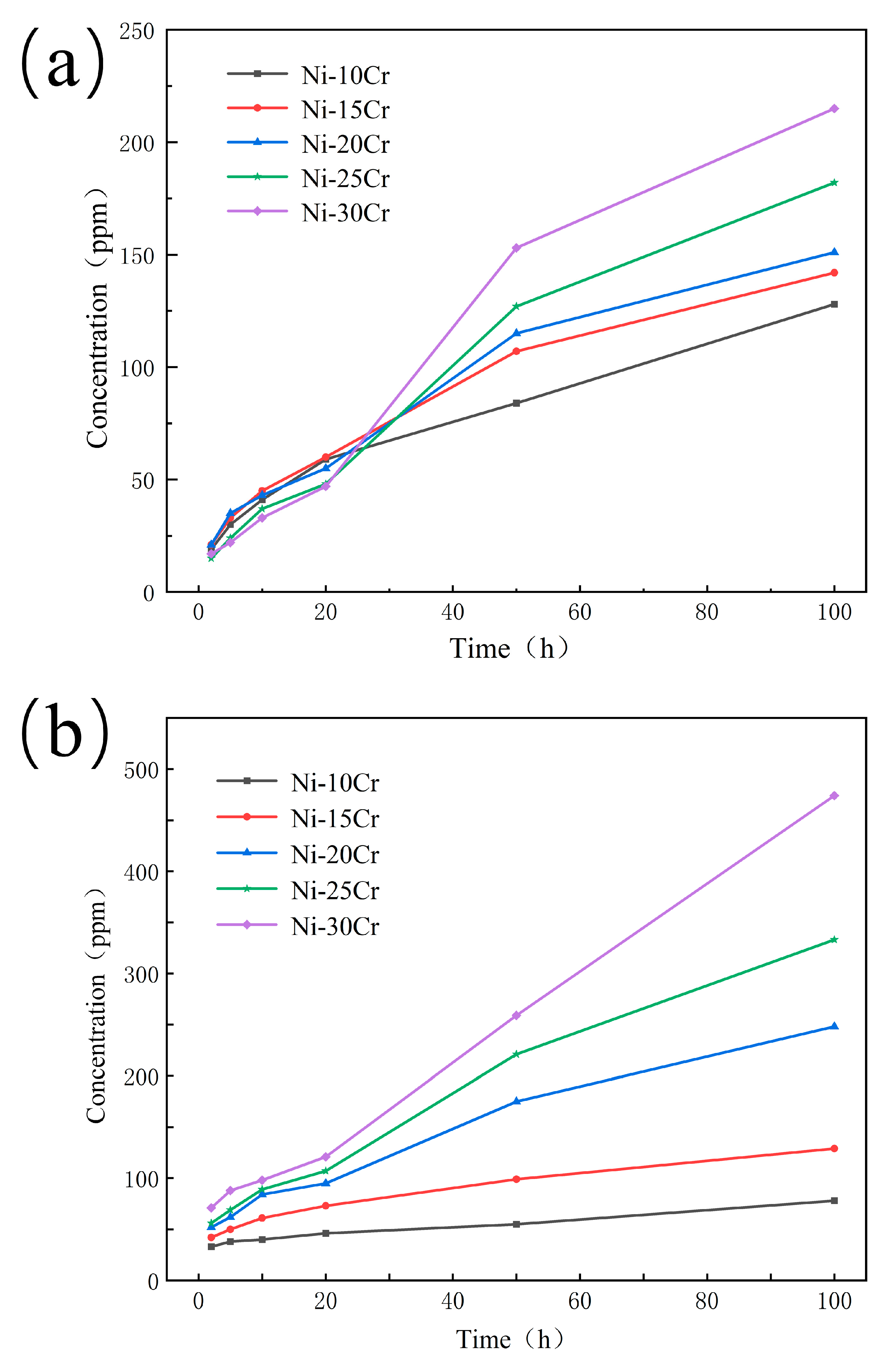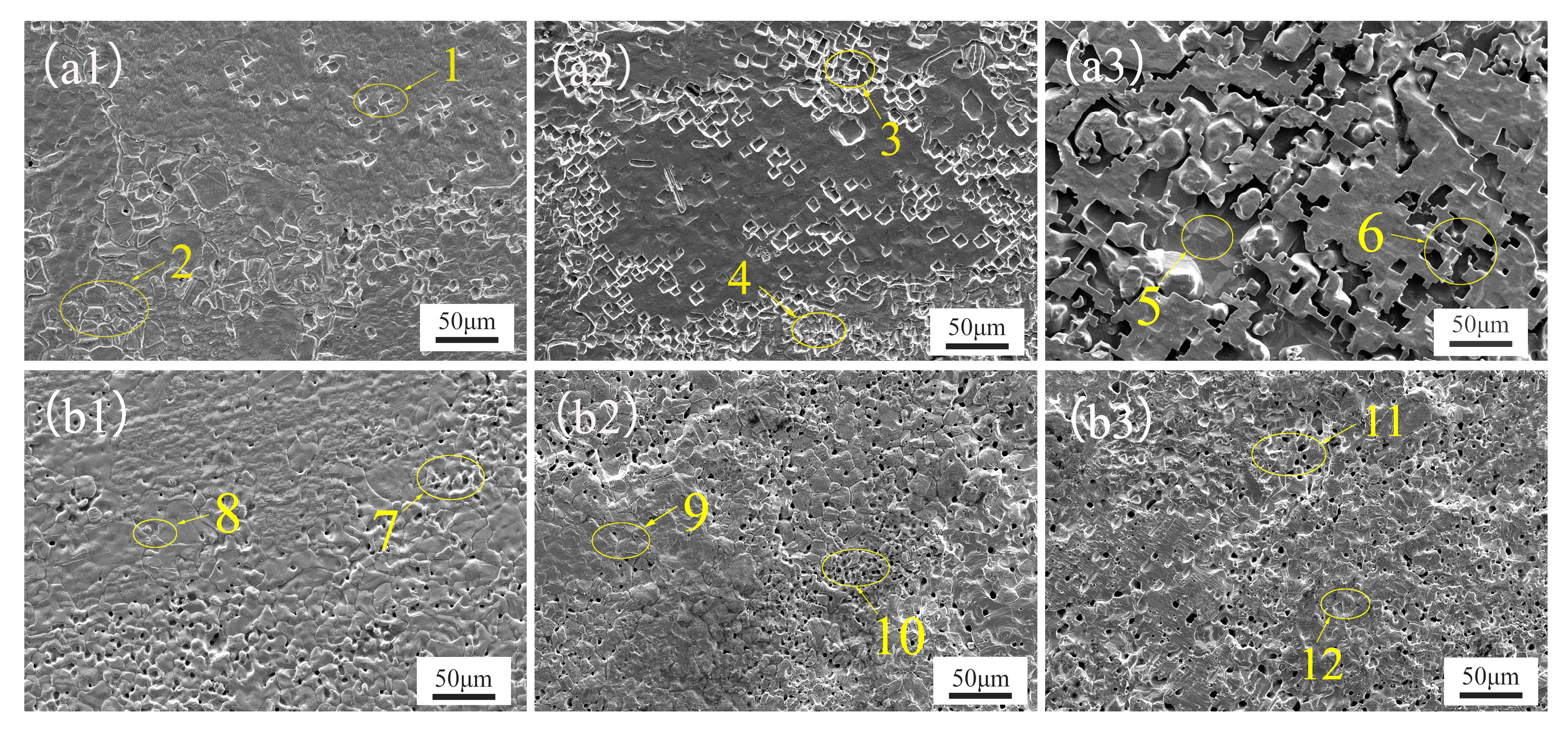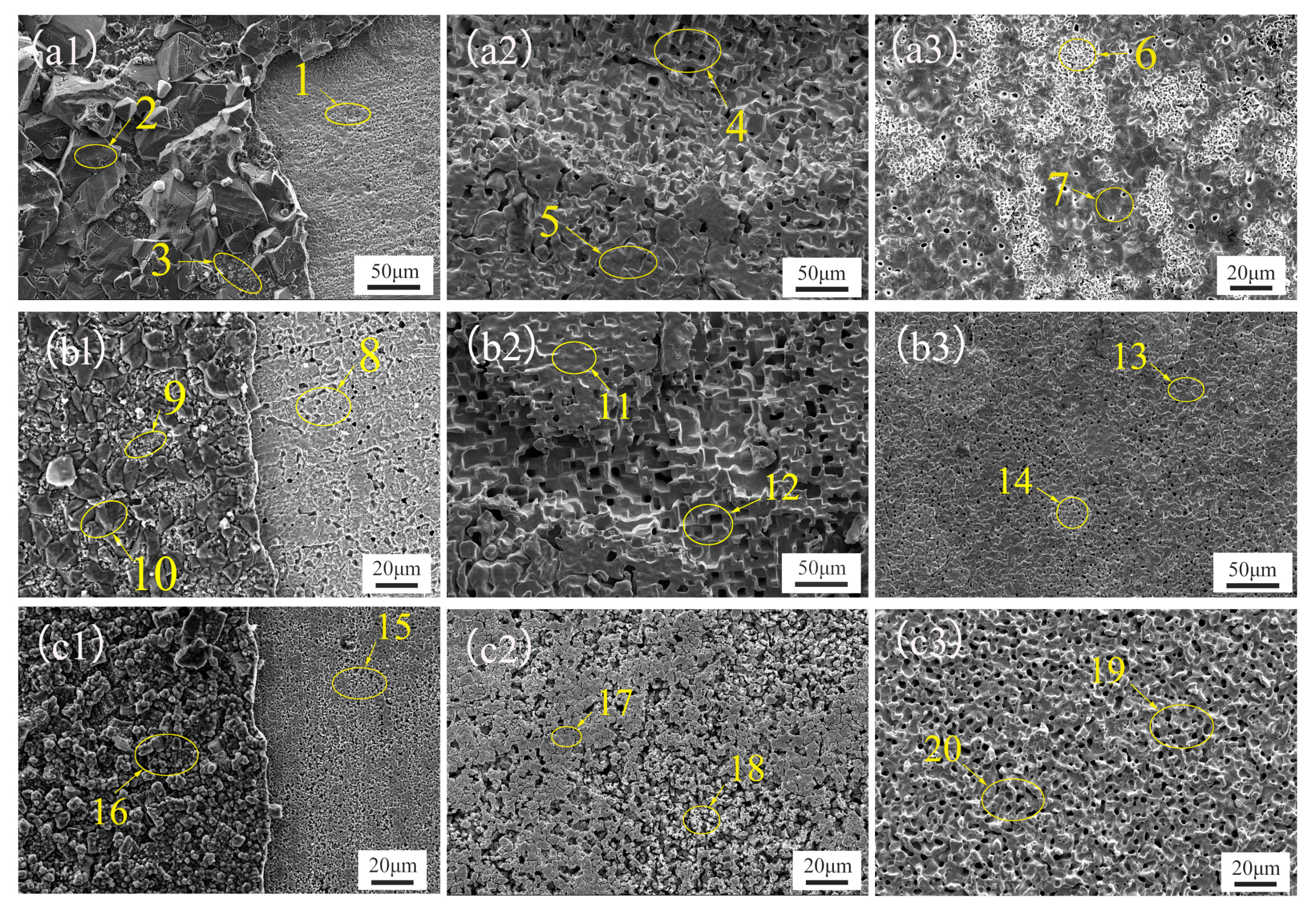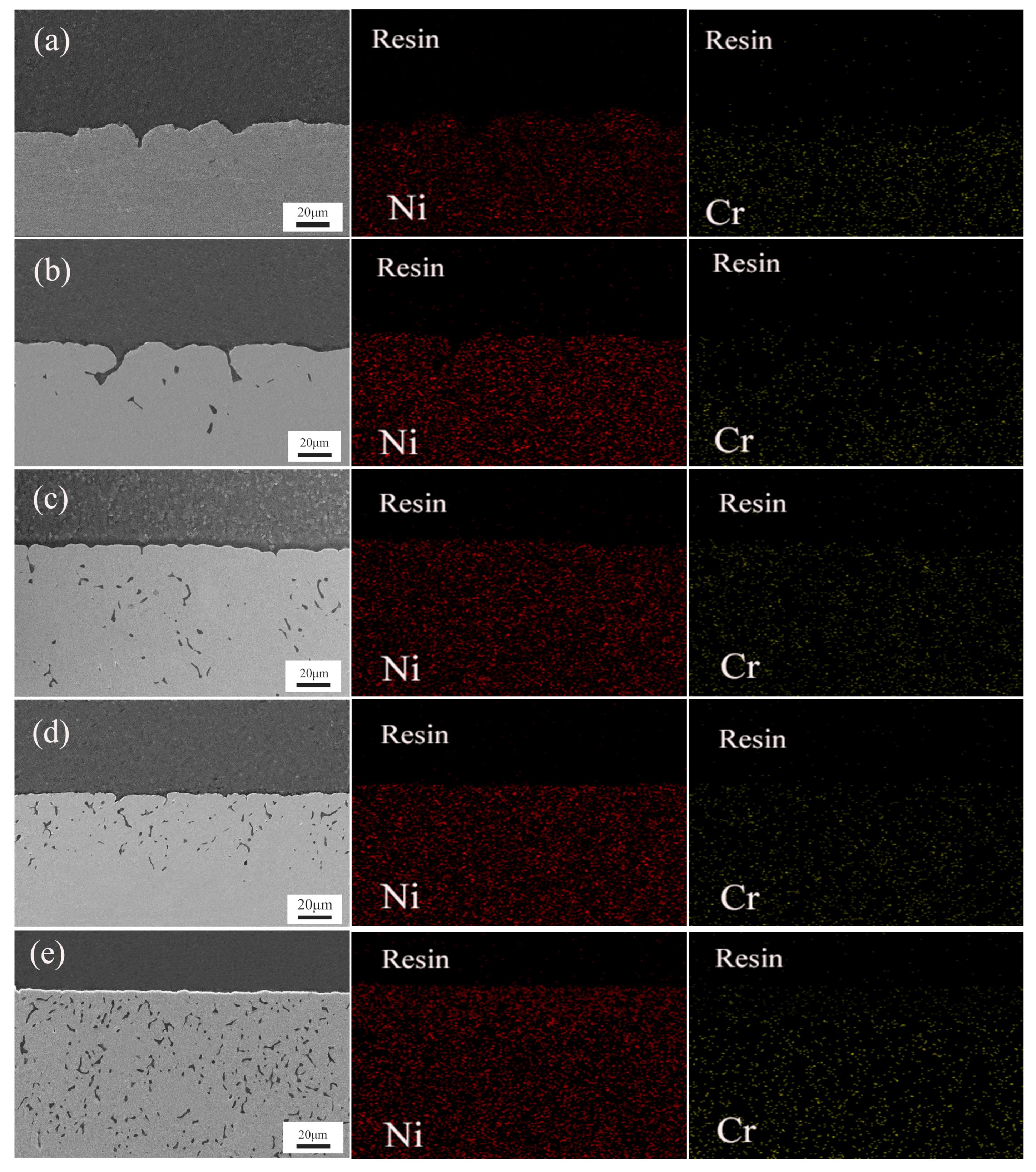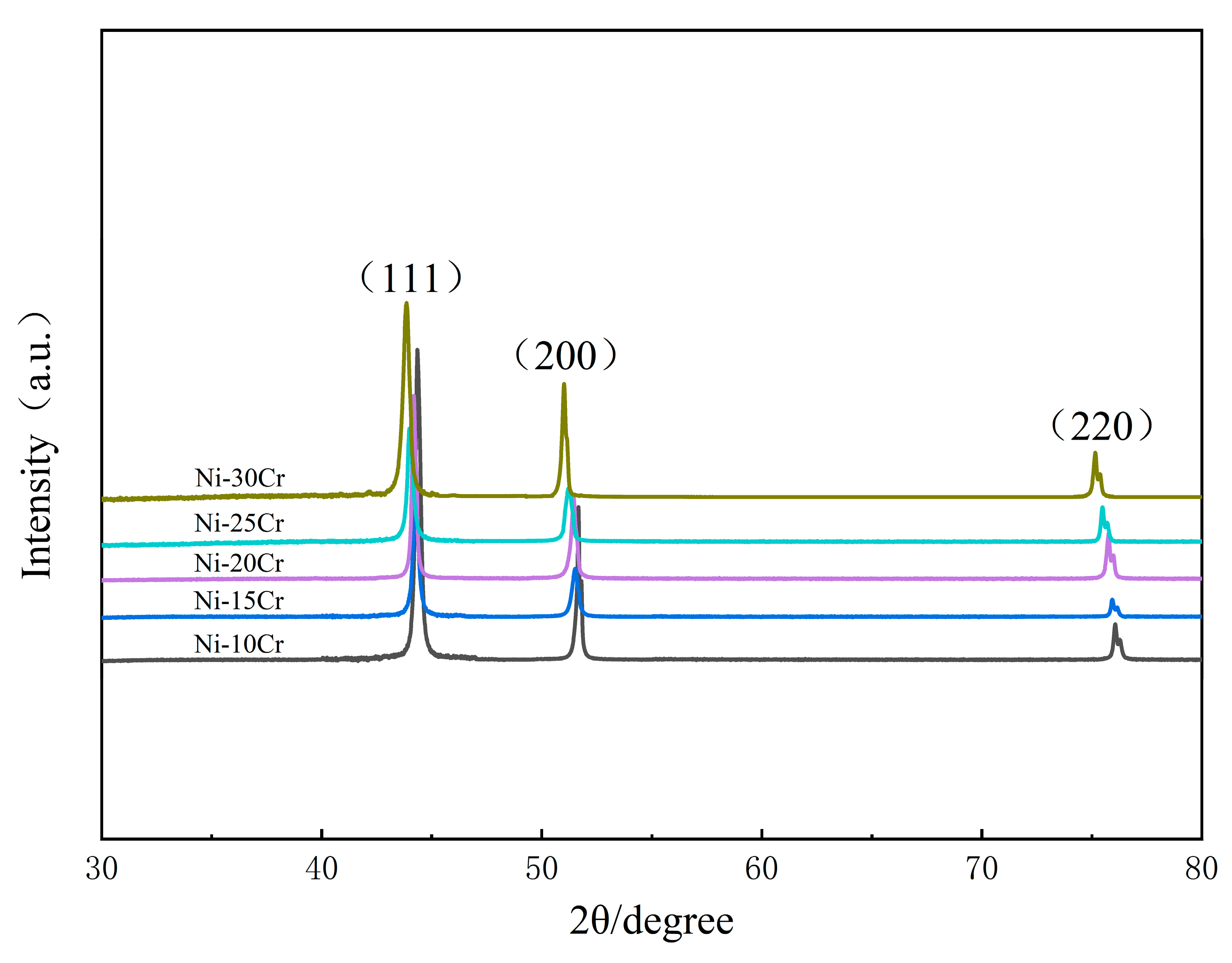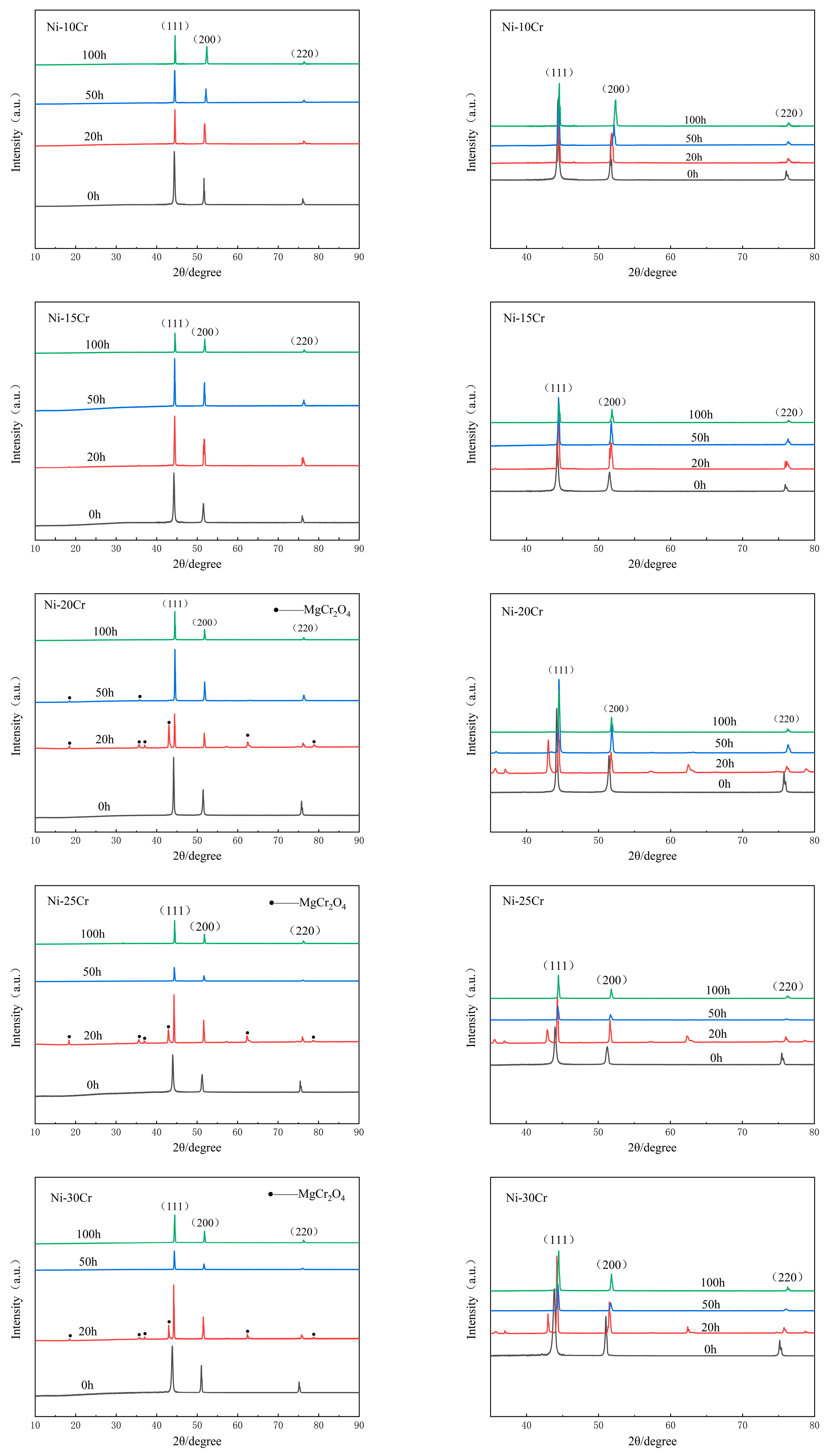3.1. Mass Change Experiment
The mass loss of five Ni-Cr alloys with different Cr contents submerged in NaCl-KCl-MgCl
2 molten salt at 700 °C for durations of 2 h, 5 h, 10 h, 20 h, 50 h, and 100 h is illustrated in
Figure 2.
Figure 2 reveals that during the initial stages of corrosion (2 to 10 h), the mass loss of all alloys increases with the duration of exposure. In this phase, alloys with lower Cr content, such as Ni-10Cr and Ni-15Cr, exhibit lesser mass loss compared to those with higher Cr content, like Ni-30Cr. This trend might be attributed to the higher Cr content facilitating the formation of more corrosion products in the initial stages, leading to greater mass loss in the short term. By the 20 h mark, the situation becomes particularly interesting. For Ni-25Cr and Ni-30Cr alloys, a significant reduction in mass loss is observed, especially for the Ni-30Cr alloy, which shows almost no loss. This could indicate the formation of a protective oxide layer on these alloys in the corrosive environment, slowing down the corrosion process. However, the mass loss for Ni-10Cr, Ni-15Cr, and Ni-20Cr continues to increase steadily at 20 h. By 50 h, all alloys experience an increase in mass loss, notably for the Ni-30Cr alloy, suggesting that even the presence of a protective layer can result in its breakdown or other forms of accelerated corrosion over prolonged exposure. At 100 h, significant increases in mass loss are noted across all alloys, with the highest content alloy (Ni-30Cr) experiencing the greatest loss throughout the experiment, reaching 44.87 mg/cm². This indicates that over the long term, increased Cr content may lead to more corrosion product accumulation or breakdown of the oxide layer.
These data suggest that while an increase in Cr content may not reduce alloy mass loss in the initial stages, over a certain period, a higher Cr content can lead to the formation of a more stable protective layer on the alloy’s surface, thereby slowing the corrosion rate. However, over extended periods of corrosion, alloys with high Cr content do not appear to exhibit superior corrosion resistance. This underscores that for Ni-Cr alloys’ corrosion resistance, not only is the Cr content itself significant, but so too is the behavior of the alloy in specific corrosive environments. Further research is needed to optimize alloy compositions for superior corrosion resistance in molten salt environments.
3.2. ICP-OES
Figure 3 presents the dissolution quantities of Ni and Cr elements, measured in parts per million (ppm) through Inductively Coupled Plasma Optical Emission Spectrometry (ICP-OES), for five different Ni-Cr alloys corroded in NaCl-KCl-MgCl
2 molten salt over various durations. By integrating the ICP-OES dissolution data with the mass loss figures, we can delineate the corrosion process into three distinct phases for a more nuanced analysis:
In the initial phase, there is a rapid increase in the dissolution rates of Cr, particularly noticeable in the Ni-30Cr alloy. This suggests that despite the formation of an oxide layer on the alloy surface, this layer is not sufficiently stable in the early stages to effectively prevent chromium dissolution. Meanwhile, the dissolution rate of Ni also increases but at a comparatively slower pace. This indicates that Ni might be more stable during the initial stages of corrosion, or that chromium is more prone to dissolution. In this phase, the Ni-25Cr and Ni-30Cr alloys exhibit relatively lower mass loss, which could be attributed to the formation of an initial, somewhat protective oxide layer on the surface due to the higher Cr content [
19].
- 2.
Mid-term Corrosion (20 to 50 h)
A notable increase in Cr dissolution is observed across all alloys, especially in the Ni-30Cr alloy, indicating that the corrosion mechanism may have transitioned, such as through molten salt permeating the oxide layer or localized fracturing of the oxide layer. During this stage, a steady increase in Ni dissolution suggests ongoing corrosion attacks on the Ni matrix. The reduced mass loss observed in the Ni-25Cr and Ni-30Cr alloys at 20 h may be attributed to the formation of a more comprehensive oxide layer, which provides improved protection during the mid-term corrosion phase.
- 3.
Long-term Corrosion (100 h)
Significant increases in Cr dissolution across all alloys, particularly those with high Cr content, align with the long-term trends in mass loss. This suggests that, despite the presence of oxide layers, prolonged corrosion leads to notable Cr dissolution. The Ni-30Cr alloy exhibits the highest Ni and Cr dissolution after extended corrosion, supporting the hypothesis that protective layers formed in high Cr content alloys may fail over time, accelerating corrosion. The trend of Ni dissolution is relatively stable but also significantly increases over the long term, indicating that Ni corrosion is a slow yet persistent process.
Considering the entire corrosion process, alloys with higher Cr content may initially form thicker oxide layers, but the stability of these layers in corrosive environments, especially under long-term corrosion conditions, warrants further investigation. The significant impact of Cr dissolution on alloy mass loss highlights the selective corrosion of Cr as a key factor. High Cr dissolution during prolonged corrosion may relate to degradation of the protective layer or other microstructural changes. In designing Ni-Cr alloys, enhancing initial corrosion resistance by increasing Cr content is important, but optimizing overall corrosion resistance to withstand long-term corrosive environments is equally crucial. This may involve adjusting other elements in the alloy or developing new alloy treatment techniques to enhance the stability of the oxide layer.
3.3. Surface SEM Analysis
The surface scanning electron microscope (SEM) images of Ni-Cr alloys with five different Cr contents after 20 h, 50 h, and 100 h of corrosion in a NaCl-KCl-MgCl2 mixed salt at 700 °C are shown in
Figure 4 and
Figure 5. Specifically,
Figure 4 presents the SEM images of the alloys with low Cr content (Ni-10Cr, Ni-15Cr), while
Figure 5 shows those of the alloys with high Cr content. The elemental mass fractions obtained from the EDS analysis of the corresponding regions in
Figure 4 and
Figure 5 are listed in
Table 3.
Figure 4(a1–a3) illustrate the surface morphology of Ni-10Cr after 20 h, 50 h, and 100 h of corrosion, respectively. After 20 h of exposure, the surface of the Ni-10Cr alloy exhibited fine corrosion pits and slight etching, characteristic of localized pitting corrosion typically observed at lower chromium contents. As the corrosion progressed to 50 h, both the depth and breadth of corrosion intensified, with pitting expanding to form larger cavities. The material at the edges might begin to flake off due to the failure of local protective layers, indicating signs of intergranular corrosion. With further corrosion time extended to 100 h, the corrosion pits and etching on the surface became more pronounced, suggesting an advancing corrosion process, potentially transitioning to more concentrated pitting and intergranular corrosion, especially at internal and interfacial areas of the material.
For Ni-15Cr,
Figure 4(b1–b3) reveal surface corrosion phenomena after 20 h of exposure, characterized by numerous tiny corrosion pits. These small yet numerous pits indicate that even an early stage of corrosion could not be completely prevented by the increased Cr content. After 50 h of corrosion, the number of pits significantly increased and were more densely distributed. Although the size of individual pits remained relatively small, the corrosion had covered a more extensive area overall. This reflects that despite the protective role of increased Cr content, the corrosion process continued unabated, predominantly in the form of micropitting. By 100 h, the number of pits on the alloy surface further increased, with some beginning to merge into larger corroded areas. Although these pits were still relatively smaller compared to those on Ni-10Cr alloy, their sheer number was significantly higher than that of Ni-10Cr. This may imply that although a higher Cr content was present, the effectiveness of the corrosion protection layer was limited over the long term, failing to prevent the occurrence and development of corrosion. In summary, both low-Cr alloys exhibited the formation of pits at the initial stage of corrosion, but as time progressed, the pits on Ni-10Cr alloy became larger and deeper, whereas Ni-15Cr alloy showed a higher number of finer pits. This could reflect the impact of Cr content on the corrosion morphology, where a higher Cr content, although unable to prevent pit formation, appeared to slow down the pit enlargement process. This suggests that chromium plays a role in inhibiting the expansion of corrosion pits; however, the number of pits continued to increase. These fine pits could converge into larger corroded areas over a longer corrosion duration, leading to an overall elevation in the level of corrosion.
Table 3 displays the elemental distribution in the corroded areas identified in the SEM images, and the analysis of EDS data and SEM imagery reveals the selective corrosion characteristics of Cr and its progression over time in the Ni-10Cr and Ni-15Cr alloys immersed in a NaCl-KCl-MgCl
2 molten salt. For the Ni-10Cr alloy, after 20 h of corrosion, the relatively high content of Cr suggests that a protective layer of Cr might have formed on the alloy surface under the initial influence of the molten salt. After 50 h, the Cr content begins to decrease in certain areas, likely due to Cr experiencing a more rapid dissolution process in these regions. The Cr oxide layer is compromised, exposing the underlying Ni matrix. After 100 h, the Cr content in some areas drops to zero, indicating that Cr has completely corroded away from these areas, leaving behind regions enriched in Ni. These areas exhibit larger corrosion pits and more extensive etching in the SEM images, indicating a progression to more severe corrosion as the protective Cr layer is breached and depleted.
For the Ni-15Cr alloy, after 20 h of corrosion, the Cr content remains high, yet compared to the Ni-10Cr alloy, a greater number of small corrosion pits begin to appear. This indicates that even with a higher Cr content, selective corrosion cannot be completely prevented. As corrosion time extends to 50 and 100 h, the detected Cr content in the corroded areas continues to decrease. This decline in Cr content corresponds with an increase in corrosion pits, and the surface morphology indicates that corrosion is still progressing. Unlike the Ni-10Cr alloy, despite having more chromium, the anticipated stronger protective effect was not observed. Instead, the corrosion appears to be more dispersed and widespread. After 100 h, although chromium has not entirely vanished, the ubiquity of corrosion and the distribution of pits suggest that the effectiveness of the chromium protective layer in resisting ongoing corrosion is diminishing.
These observations might suggest that while theoretically, increasing chromium content should offer better protection, in these alloys, corrosion instead intensified with increased chromium content. A possible explanation is that the increased chromium content makes the alloy more susceptible to selective corrosion, especially in areas where a complete protective layer has not formed, or where the protective layer has been breached for some reason, leading to faster chromium depletion. Another potential factor is that, although chromium forms protective oxide layers, these layers may not be stable enough under the action of the corrosive medium, or regions of chromium enrichment in the alloy may become preferred points of attack for corrosion, also leading to faster overall chromium loss and thereby exacerbating corrosion.
From this analysis, it is evident that as the Cr content increases from 10 wt% to 15 wt%, the corrosion behavior of Ni-Cr alloys in a NaCl-KCl-MgCl2 molten salt exhibits a non-intuitive pattern, where the degree of corrosion does not decrease noticeably with higher Cr content, and in some instances, appears to worsen. To further clarify the relationship between Cr content and corrosion behavior, as well as to explore the optimal balance of Cr content in alloy design, it becomes necessary to investigate the performance of Ni-Cr alloys with higher Cr contents under the same corrosive conditions.
Figure 5 showcases the surface scanning electron microscope (SEM) photographs of high-Cr-content Ni-Cr binary alloys (Ni-20Cr, Ni-25Cr, Ni-30Cr) after corrosion in a NaCl-KCl-MgCl
2 molten salt.
Table 4 presents the results of the energy-dispersive spectroscopy (EDS) point scans conducted on the surfaces of the three alloys following the corrosion tests. Through the analysis of SEM images and EDS data, an assessment can be made regarding the behavior of these three high-Cr-content Ni-Cr alloys in the NaCl-KCl-MgCl
2 molten salt environment over varying corrosion durations.
For these three alloys, SEM images taken after 20 h show the formation of a distinct protective film in certain areas, while EDS data reveal that these films primarily comprise Mg, Cr, and O. This indicates that in the molten salt environment, Cr and Mg may react with oxygen to form a protective oxide layer on the alloy surface. However, in areas where the protective layer has not formed, the alloys still suffer significant corrosion, suggesting that the formation of the protective layer might be uneven. This unevenness could lead to concentrated attacks by the corrosive medium in unprotected areas, exacerbating local corrosion phenomena.
As corrosion progresses to 50 h, the protective films observed at 20 h are no longer evident in the SEM images, possibly indicating that the protective layers have been compromised and eroded by the molten salt. The disappearance of the protective films could be due to the insufficient stability of Cr and Mg oxides to withstand the long-term high-temperature molten salt environment, allowing the corrosion process to penetrate through the protective layer and continue corroding the underlying alloy. The alloy surfaces become rougher and more irregular, and the shape and distribution of pits suggest that the initially uniform corrosion has begun to shift towards localized and concentrated corrosion. This shift could be a result of the corrosive medium directly reacting with the alloy substrate following the rupture of the protective layer. This type of corrosion may include pitting, as deeper corrosion pits are observed in localized areas. On the other hand, some smoother areas might still retain remnants of the protective layer, exhibiting less severe corrosion. This indicates that the presence of the protective layer has a certain effectiveness in resisting corrosion.
In our investigation into the corrosion behavior of low-Cr-content Ni-Cr alloys, we encountered an intriguing phenomenon: contrary to expectations, increasing the Cr content did not decelerate the corrosion process but instead led to a higher number of corrosion pits. This trend of worsening corrosion morphology with added Cr content was also confirmed in alloys with higher Cr concentrations. Through SEM imaging and EDS analysis, it was observed that alloys with higher Cr content, such as Ni-20Cr, Ni-25Cr, and Ni-30Cr, exhibited a significant increase in the number of corrosion pits, suggesting that an increase in Cr content might have, to some extent, facilitated the formation of new corrosion sites. This discovery underscores an important concept: in Ni-Cr alloys, merely increasing the chromium content does not necessarily offer better corrosion protection. On the contrary, an excess of chromium might become a catalyst in the corrosion process due to its selective corrosion in the corrosive environment. This could be related to the heterogeneity of chromium-rich areas or to the quality and stability of chromium oxide protective layers. In high-temperature molten salt corrosion environments, these protective layers might become more susceptible to damage, thereby manifesting as exacerbated corrosion at the macroscopic level.
3.4. Cross-Sectional SEM and EDS Analysis
Figure 6 presents the SEM images of the cross-sections of Ni-Cr binary alloy blocks with varying Cr contents after 100 h of corrosion in a NaCl-KCl-MgCl
2 molten salt at 700 °C, accompanied by their EDS surface scanning elemental analysis. When analyzing the EDS results of the Ni-Cr alloys with different Cr contents, we noticed the presence of Cr-depleted regions across all alloys. This indicates that the Cr elements in these areas were preferentially dissolved during the corrosion process, serving as direct evidence of selective Cr corrosion. The SEM image of the Ni-15Cr alloy notably reveals the formation of holes due to corrosion, which are the result of the corrosive medium penetrating through the protective layer and eroding the substrate.
Figure 6a displays the SEM image of the Ni-10Cr alloy’s cross-section, which appears comparatively uniform with mild corrosion. The EDS analysis shows an even distribution of Ni and Cr, indicating that at lower Cr contents, the impact of corrosion is limited. As the Cr content increases,
Figure 6b reveals more pronounced corrosion in the SEM image, with the emergence of holes suggesting that corrosion can penetrate the initial protective layer and begin to impact the alloy’s substrate even at relatively lower Cr contents. The EDS results highlight a significant reduction in Cr content as corrosion progresses, especially near corrosion pits, making the Cr-depleted regions more pronounced [
20].
Figure 6c–e illustrate that with an increase in Cr content, the number of holes in the SEM images significantly multiplies, and surface corrosion becomes more evident, indicating more severe localized corrosion phenomena. In the Ni-20Cr, Ni-25Cr, and Ni-30Cr alloys, the increase in Cr-depleted regions as shown in the EDS results correlates positively with the increase in the number of holes, suggesting a direct link between Cr depletion and the degree of alloy corrosion. In alloys with higher Cr contents, the proliferation of Cr-depleted areas implies that, despite a higher overall Cr content, once Cr-depleted regions form, they become susceptible points for corrosion. The selective corrosion of Cr leaves the remaining Ni matrix more vulnerable to erosion by the corrosive medium.
The analysis results from the cross-sectional SEM images and EDS data are consistent with conclusions drawn from mass loss experiments and observations from surface SEM and EDS: as the Cr content in Ni-Cr alloys increases, the severity of corrosion actually escalates. Cross-sectional SEM analysis reveals that with higher Cr content, the internal structure of the alloys becomes increasingly unstable, and porosity increases, indicating more pronounced internal corrosion phenomena. This is further corroborated by EDS analysis, showing that high-Cr-content alloys have more extensive Cr-depleted areas, directly correlating with increased corrosion severity. Mass loss experiments reveal greater mass loss in high-Cr-content alloys with prolonged corrosion time. These experimental outcomes correspond with observations of selective Cr corrosion and increased pore formation from cross-sectional SEM and EDS analyses. Observations from surface SEM and EDS also support this finding, revealing more porosity and corrosion pits on the alloy surfaces as Cr content increases.
This series of analyses highlights a critical issue: in specific corrosive environments, simply increasing the Cr content in an alloy does not necessarily enhance its corrosion resistance. On the contrary, a high Cr content might lead to exacerbated corrosion due to increased selective Cr corrosion. This could be related to the microscale heterogeneity of high-Cr-content alloys, which form Cr-depleted regions vulnerable to attack in corrosive environments, thereby becoming hotspots for accelerated corrosion.
Therefore, when designing Ni-Cr corrosion-resistant alloys for use in high-temperature molten salt environments, considerations should extend beyond Cr content to include the uniformity of Cr distribution, the microstructure of the alloy, and other factors that may affect corrosion behavior. These findings provide important guidance for optimizing alloy corrosion resistance, pointing towards directions for future research, especially in the development of high-performance corrosion-resistant materials.
3.5. X-ray Diffraction Analysis
Figure 7 presents the XRD patterns of Ni-Cr binary model alloys with different ratios. It can be observed from the figure that alloys with a Cr content of less than 30 wt.% all fall within the gamma (γ) solid solution phase of nickel, with no new precipitate phases appearing during the processes of melting, rolling, or high-temperature annealing [
21]. As illustrated in
Figure 7, as the Cr content in the model alloys increases, the peak positions gradually shift to the left. According to Bragg’s law, this leftward shift of peak positions is primarily due to an increase in the lattice constant. Bragg’s law is as follows:
In the formula, d represents the interplanar spacing, θ is the angle between the incident X-rays and the crystal plane, n is the diffraction order, λ is the wavelength of the incident X-rays, and it is a constant. The formula indicates that when the peak positions shift to the left, indicating a decrease in θ, the value of d increases, meaning the lattice constant becomes larger. According to the periodic table, the atomic radius of Cr is larger than that of Ni. When Cr and Ni form a substitutional solid solution, it causes lattice distortion in Ni. As the Cr content in the alloy increases, the lattice distortion of Ni gradually intensifies, leading to an increase in the lattice constant.
Figure 8 shows the XRD patterns of binary Ni-Cr alloys after corrosion. In the patterns for low-Cr alloys (Ni-10Cr, Ni-15Cr), apart from the three strong peaks of Ni, no new peaks appear, indicating the absence of insoluble corrosion products adhering to the alloy surface after corrosion. For high-Cr alloys (Ni-20Cr, Ni-25Cr, Ni-30Cr), in addition to the three strong Ni peaks, clear peaks of magnesiochromite (MgCr
2O
4) can be observed in the spectra after 20 h of corrosion. This suggests that the protective film composed of Mg, Cr, and O observed on the surface of high-Cr alloys in previous SEM and EDS analyses is chemically MgCr
2O
4. With the corrosion duration extending to 50 and 100 h, except for the Ni-20Cr alloy, which still shows residual MgCr
2O
4 peaks after 50 h of corrosion, the surfaces of other high-Cr alloys do not display MgCr
2O
4 peaks after 50 and 100 h of corrosion. This indicates that MgCr
2O
4 formed on the surface of high-Cr alloys also gradually corrodes over time, which is consistent with the SEM and EDS analysis results.
Comparative analysis of the peak positions in the XRD patterns of different ratios of Ni-Cr alloys after varying corrosion durations, as seen in
Figure 8, reveals that the three strong peaks of Ni-Cr alloys gradually shift to the right with the prolongation of corrosion time. This peak shift further corroborates the selective corrosion behavior of Cr. The corrosion of Cr on the alloy surface leads to the formation of vacancies, and during the high-temperature corrosion process, the accumulation of vacancies in the Ni-Cr alloy causes the gradual formation of a pure Ni lattice structure in the corroded areas of the alloy surface.
Compared to
Figure 7, the X-ray diffraction (XRD) peaks of Ni-Cr binary alloys with different compositions after corrosion exhibit differences, yet they show a converging trend. Calculations based on Bragg’s equation indicate that, before corrosion, the interplanar spacings for the (110), (200), and (220) crystal planes of Ni-Cr binary alloys were within the ranges of 2.0409 <
d < 2.0572, 1.7676 <
d < 1.7814, and 1.2568 <
d < 1.2623, respectively. After 100 h of corrosion, these ranges narrowed to 2.0348 < d < 2.0366, 1.7622 <
d < 1.7629, and 1.2465 <
d < 1.2473, respectively, indicating that the alloy’s interplanar spacings began to approach those of pure nickel (Ni). The interplanar spacings of the (110), (200), and (220) crystal planes for pure Ni are
d = 2.0344,
d = 1.7619, and
d = 1.2458 (PDF#04-003-1538), respectively, showing that the crystal lattice structure of the Ni-Cr alloys after corrosion tends toward the lattice parameters of pure Ni.
This change reveals the significant impact of the corrosion process on the crystal structure of Ni-Cr binary alloys, particularly how the loss of Cr elements causes the alloy lattice to gradually shift toward the structure of pure Ni. Such alterations in lattice parameters offer an important perspective for understanding the behavior of Ni-Cr alloys in corrosive environments. This also highlights the crucial influence of alloy composition on its corrosion resistance properties.
